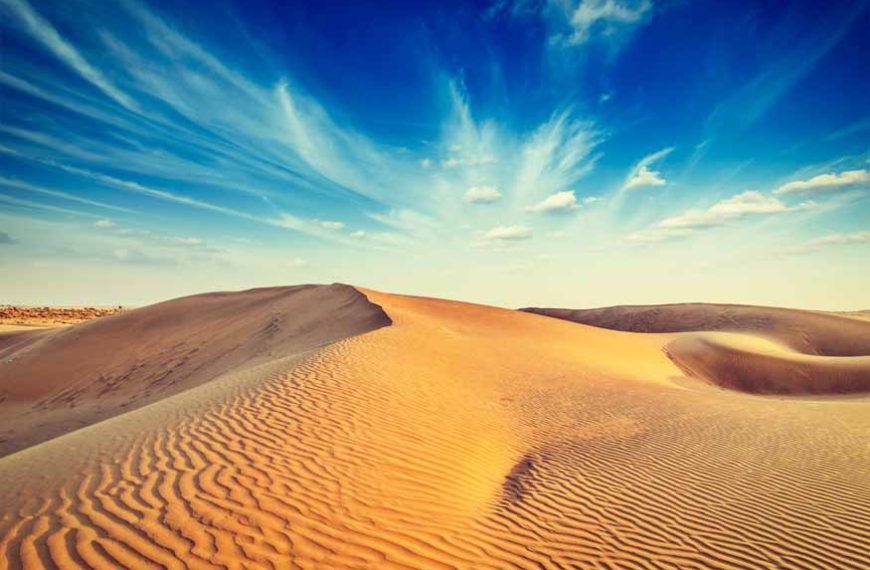India is a land of diversities – be it culture, food, language, or landscape. Among its varied landscapes, the deserts hold a special allure. They are vast, barren, and enchanting, offering a unique experience to travellers. If you’re planning to explore the arid terrains of India, here is a list of the top 5 deserts in India you should consider visiting. So, what are we waiting for? Let us get into the list of deserts in India!
“The Thar Desert covers some 77,000 square miles (200,000 square km) of territory. It is bordered by the irrigated Indus River plain to the west, the Punjab Plain to the north and northeast, the Aravalli Range to the southeast, and the Rann of Kachchh to the south. The subtropical desert climate there results from persistent high pressure and subsidence at that latitude. The prevailing southwest monsoon winds that bring rain to much of the subcontinent in summer tend to bypass the Thar to the east. The name Thar is derived from thul, the general term for the region’s sand ridges.”
– Britannica
5 Amazing Deserts of India
1. Thar Desert – The Largest Desert in India
Known by most as the Great Indian Desert, the Thar Desert is a vast, sandy desert that stretches into sections of Pakistan and the northwest region of India. Encompassing extensive swathes of Rajasthan, Haryana, Punjab, and Gujarat, this is the largest desert in India and the 17th largest in the world. It is also one of the largest deserts among the list of deserts in India.
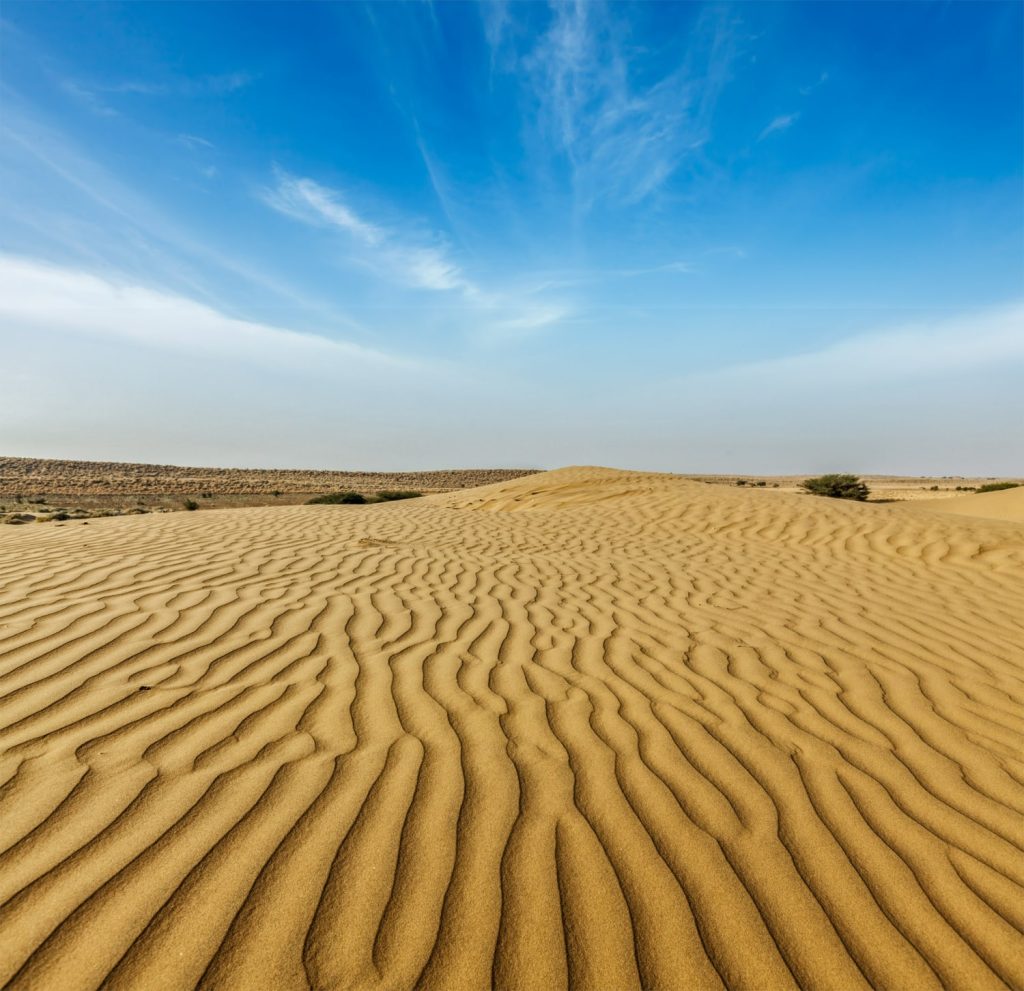
Jaisalmer: Often referred to as the ‘Golden City’, Jaisalmer is the jewel of the Thar Desert. The magnificent Jaisalmer Fort, built with golden-hued sandstone, stands tall, overlooking the city. While here, tourists can enjoy camel safaris that offer a unique perspective of the desert landscape. Moreover, the annual Desert Festival in Jaisalmer celebrates the spirit of the desert with cultural performances, camel races, and local handicrafts.
Sand Dunes: The dunes of Sam and Khuri are iconic representations of the Thar. As the sun dips, these dunes offer a mesmerising view, painting the landscape in hues of orange and red. Camel rides across these dunes are a favourite among visitors.
Cultural Performances: The Thar is not just about its landscape; it’s about its vibrant culture. Local folk music, especially the soulful strains of the ‘Manganiyars’, and the rhythmic dance forms like ‘Ghoomar’ provide tourists with a deep dive into the region’s rich cultural heritage.
2. Rann of Kutch – Where Salt meets Sand
The Rann of Kutch, located in the state of Gujarat, is a unique landscape that’s a blend of desert and salt flats. During the monsoon, the region gets submerged in water, transforming into a vast salt marsh in the dry season. While it doesn’t have the typical sand dunes associated with deserts, the shimmering white salt plains offer an enchanting view, especially on full moon nights when the entire expanse sparkles under the moonlight. It is also one of the most scenic deserts among the list of deserts in India.
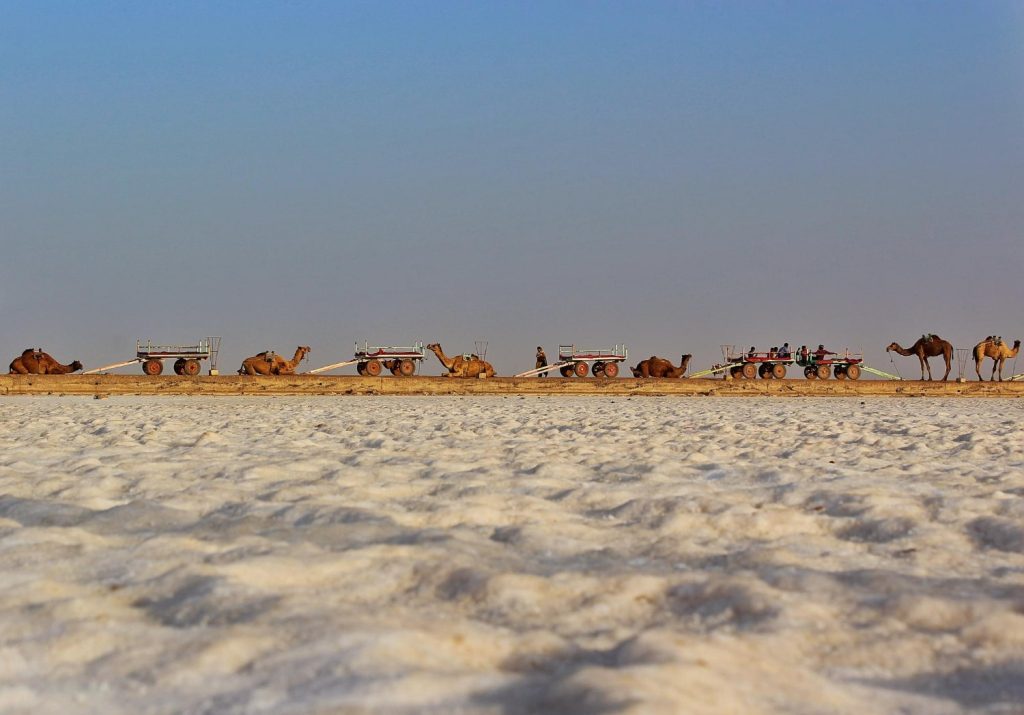
Rann Utsav: This is a grand celebration of the culture and heritage of Gujarat. Held annually in the winter months, the Rann Utsav draws tourists from all over the world. Visitors can enjoy folk dances, music performances, artisanal handicrafts, and a spread of local cuisine, all set against the backdrop of the white salt desert.
Kala Dungar: Also known as the Black Hill, Kala Dungar is the highest point in the Rann of Kutch. From here, tourists can enjoy an uninterrupted view of the vast salt plains below.
Flamingo Sanctuary: The Rann of Kutch is a haven for bird enthusiasts. Every year, the region witnesses the migration of thousands of flamingos, adding a splash of pink to the white landscape. Did you ever question ‘How many deserts are there in India?’
3. Banni Grasslands – The Green Desert
Lying adjacent to the Rann of Kutch in Gujarat, the Banni Grasslands is a unique landscape that contrasts the barren white salt flats nearby. Often called the “green desert,” its total area is estimated to be 3,847 square kilometres. The area is unique in that it combines desert and marsh plants, creating one of Asia’s richest meadows. It is also one of the crucial desert vegetation in India.
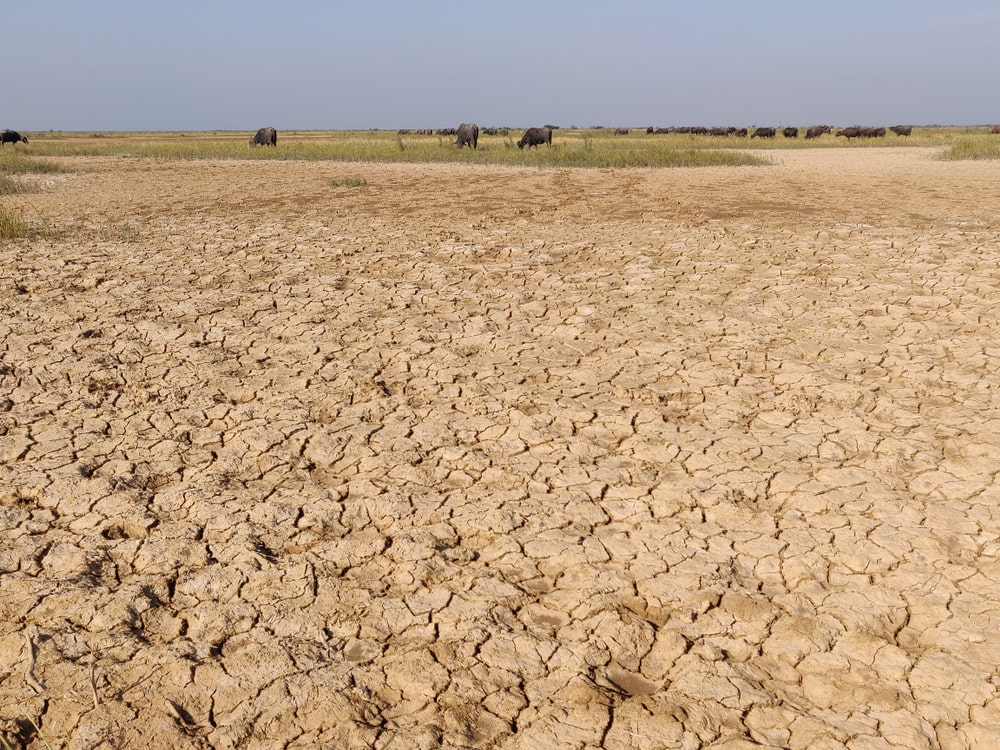
Biodiversity: The Banni Grasslands stand as a testament to the harmony of life in arid regions. The area serves as a sanctuary for numerous migratory birds, making it an ornithologist’s delight. Additionally, the region is also home to the endangered Indian Wild Ass, which can often be seen galloping freely in its natural habitat. It is the best desert vegetation in India.
Traditional Craft: The Banni region is not just about its natural wonders; it’s a hub of rich cultural and artistic traditions. Especially renowned for its intricate embroidery work, the crafts of Banni are symbolic of the heritage of the local Kutchi communities. When visiting, engaging with the local artisans gives a deeper understanding of their craftsmanship and stories woven into their art.
4. Desert National Park – A Desert Biodiversity Hotspot
Situated close to Jaisalmer in Rajasthan, the Desert National Park stands as a beacon of biodiversity in the midst of arid surroundings. Spread across an expansive area of about 3162 sq.km., this park is a remarkable representation of the desert ecosystem of the Thar Desert.
Wildlife: The park serves as a protective sanctuary for the critically endangered Great Indian Bustard. These magnificent birds are breathtaking to see, especially with their regal gait. The park also serves as a refuge for a variety of bird species, including vultures, falcons, harriers, and eagles. The sandy landscape of the park also shelters animals like the desert fox and the blackbuck. It is also one of the great deserts of India.
Fossil Evidence: The Desert National Park is not just a haven for wildlife enthusiasts but also for those keen on palaeontology. It contains valuable fossil records that date back to the Jurassic era, showcasing remnants of the time when this arid landscape was submerged under the sea.
5. Cold Desert of Spiti – The Smallest Desert in India
Nestled amidst the towering peaks of Himachal Pradesh lies the Spiti Valley, popularly known as the ‘Cold Desert’. Unlike the golden sandy stretches of Rajasthan, Spiti offers a different desert canvas painted with rugged mountains, sparse vegetation, and piercingly cold winds. The smallest desert in India has its own old world charm! It is one of the great deserts of India.
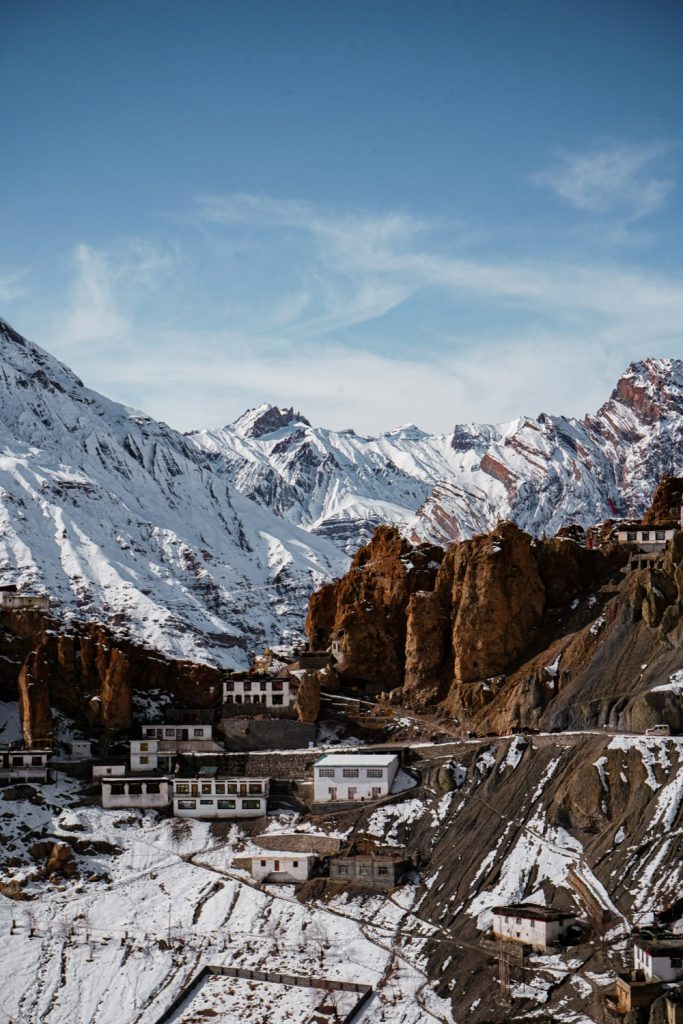
Monasteries: Spiti is dotted with ancient Buddhist monasteries that serve not only as places of worship but also as repositories of the region’s rich history. Monasteries like Key and Tabo, with their awe-inspiring architecture and murals, offer a spiritual retreat to visitors.
Landscape: The captivating landscapes of Spiti are something straight out of a postcard. The serene Chandratal Lake, with its crystal-clear waters, and the Dhankar Lake, perched high amidst the mountains, offer panoramic views that are etched in the memory of every traveller.
Star Gazing: The altitude and the clear, unpolluted skies of Spiti make it an astronomer’s paradise. Whether you’re a professional or an enthusiast, gazing at the countless stars and galaxies that adorn the night sky here is a sublime experience. That was the list containing the top 5 deserts in India. We hope that you liked the list of deserts in India. Now, let us look at some tips on travelling.
Safety and Sustainable Travel in the Deserts
While the vast expanses of India’s deserts offer a unique experience, it is crucial to approach such trips with preparedness and responsibility. Travellers should equip themselves with essentials like ample water, sun protection, and appropriate clothing. It’s always advisable to have a local guide who understands the terrain and can navigate the challenging landscape.
Equally important is the aspect of sustainable travel. The delicate ecosystem of the desert regions can easily get disturbed by irresponsible tourism. Visitors should avoid leaving behind any waste and refrain from activities that can harm the local flora and fauna. Also, while purchasing souvenirs, it’s a good practice to support local artisans and ensure that the products aren’t derived from endangered species. By travelling responsibly, we can ensure that these beautiful desert landscapes remain pristine for future generations.
Conclusion
Deserts are wondrous marvels of earth. They can be extremely hot and severely cold within the same day. In this article, we have provided a detailed description on the list of deserts for your kids. We hope to have sparked your interest to take your little one on an adventure to the deserts of India.
Now that we’re talking about experiences and nurturing, let’s not forget how crucial early learning experiences are for kids. For young minds, EuroKids offers an excellent foundation by giving them a space where they can develop, study, and flourish. As you plan your travels and seek enriching experiences for yourself, ensure your child gets the best learning experience back home. Explore EuroKids for a bright future for your little one.
Which of these great deserts of India do you plan to visit with your child to create memorable experiences?
For informative and accurate articles on all things related to your new born-toddler’s development, growth, health and nutrition, follow EuroKids Blogs and do check out our nationally recognized preschools – EuroKids for the first step in your kid’s educational journey!





